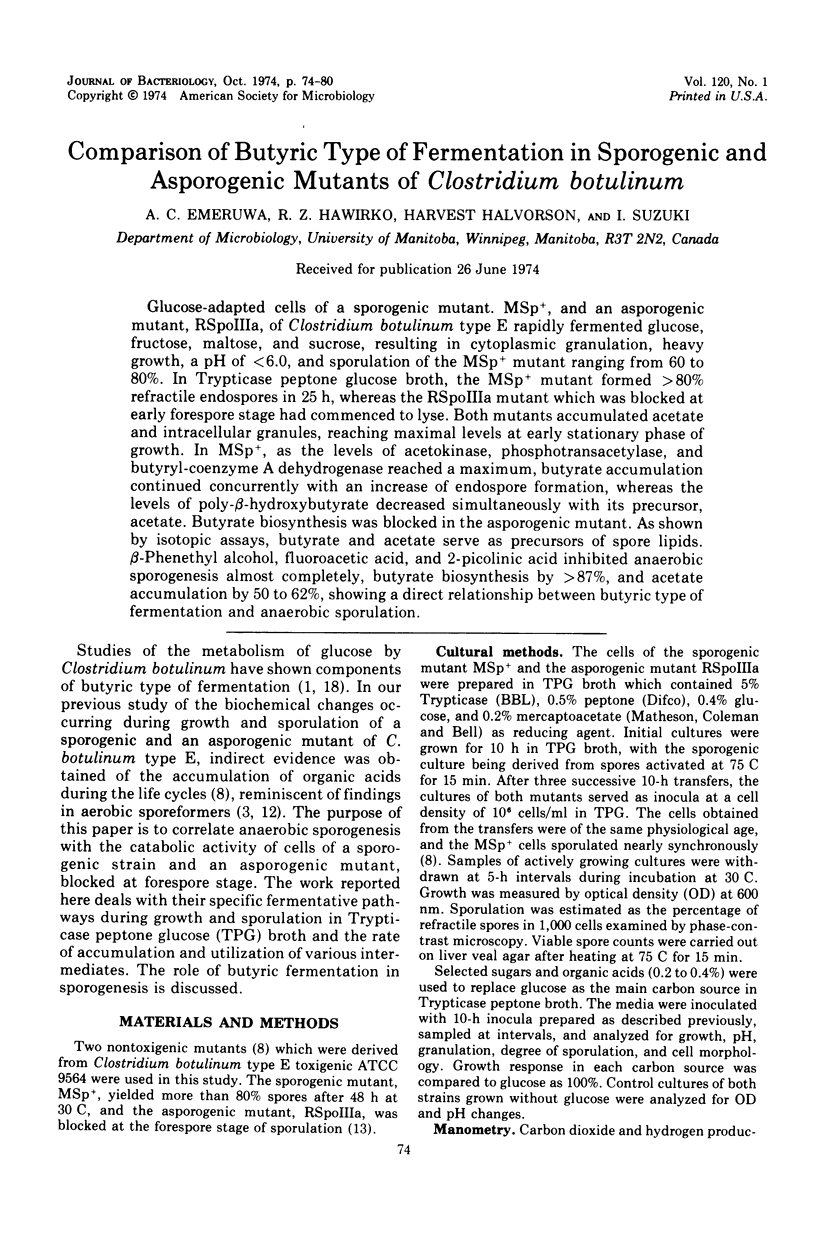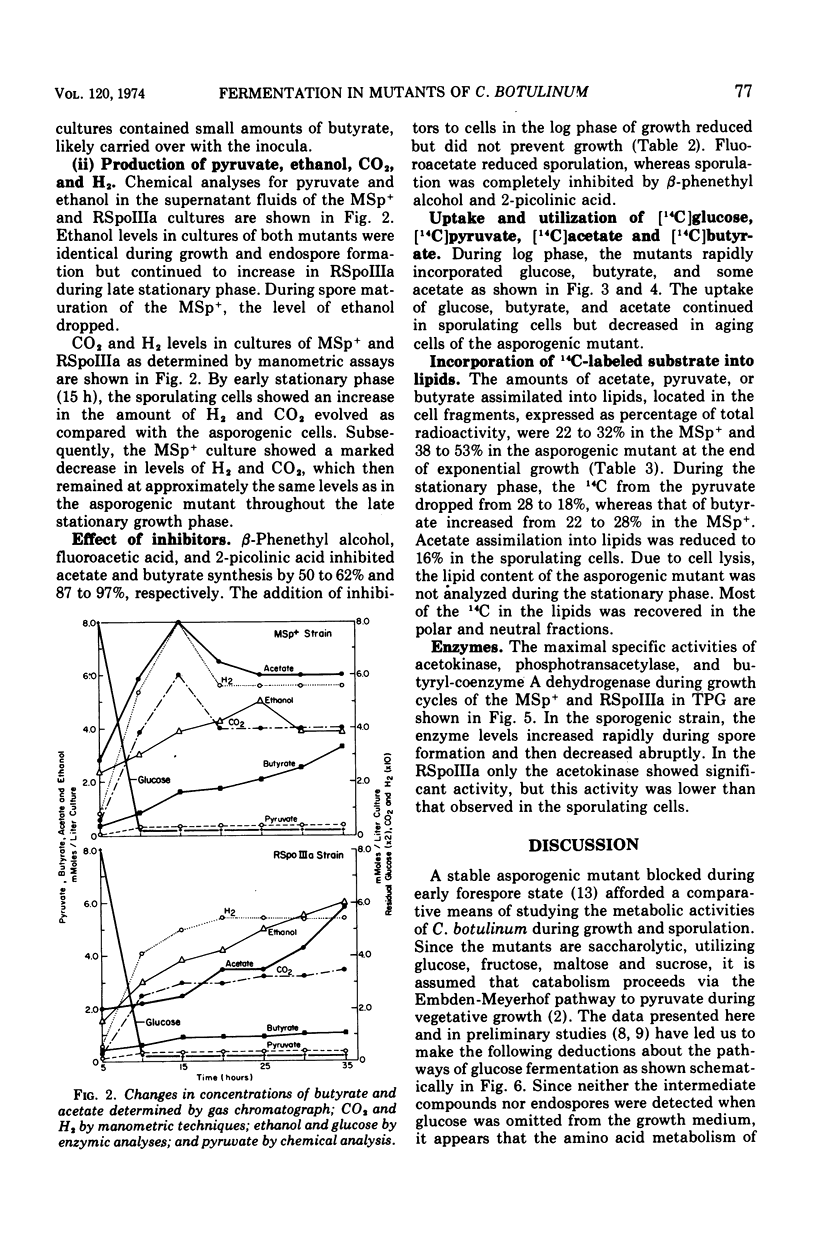Abstract
Glucose-adapted cells of a sporogenic mutant. MSp+, and an asporogenic mutant, RSpoIIIa, of Clostridium botulinum type E rapidly fermented glucose, fructose, maltose, and sucrose, resulting in cytoplasmic granulation, heavy growth, a pH of <6.0, and sporulation of the MSp+ mutant ranging from 60 to 80%. In Trypticase peptone glucose broth, the MSp+ mutant formed >80% refractile endospores in 25 h, whereas the RSpoIIIa mutant which was blocked at early forespore stage had commenced to lyse. Both mutants accumulated acetate and intracellular granules, reaching maximal levels at early stationary phase of growth. In MSp+, as the levels of acetokinase, phosphotransacetylase, and butyryl-coenzyme A dehydrogenase reached a maximum, butyrate accumulation continued concurrently with an increase of endospore formation, whereas the levels of poly-β-hydroxybutyrate decreased simultaneously with its precursor, acetate. Butyrate biosynthesis was blocked in the asporogenic mutant. As shown by isotopic assays, butyrate and acetate serve as precursors of spore lipids. β-Phenethyl alcohol, fluoroacetic acid, and 2-picolinic acid inhibited anaerobic sporogenesis almost completely, butyrate biosynthesis by >87%, and acetate accumulation by 50 to 62%, showing a direct relationship between butyric type of fermentation and anaerobic sporulation.
Full text
PDF






Selected References
These references are in PubMed. This may not be the complete list of references from this article.
- BARD R. C., GUNSALUS I. C. Glucose metabolism of Clostridium perfringens: existence of metallo-aldolase. J Bacteriol. 1950 Mar;59(3):387–400. doi: 10.1128/jb.59.3.387-400.1950. [DOI] [PMC free article] [PubMed] [Google Scholar]
- Campbell M. F., Ordal Z. J. Inhibition of sporulation of Clostridium thermosaccharolyticum. Appl Microbiol. 1968 Dec;16(12):1949–1951. doi: 10.1128/am.16.12.1949-1951.1968. [DOI] [PMC free article] [PubMed] [Google Scholar]
- DAY L. E., COSTILOW R. N. PHYSIOLOGY OF THE SPORULATION PROCESS IN CLOSTRIDIUM BOTULINUM. I. CORRELATION OF MORPHOLOGICAL CHANGES WITH CATABOLIC ACTIVITIES, SYNTHESIS OF DIPICOLINIC ACID, AND DEVELOPMENT OF HEAT RESISTANCE. J Bacteriol. 1964 Sep;88:690–694. doi: 10.1128/jb.88.3.690-694.1964. [DOI] [PMC free article] [PubMed] [Google Scholar]
- DOI R., HALVORSON H., CHURCH B. Intermediate metabolism of aerobic spores. III. The mechanism of glucose and hexose phosphate oxidation in extracts of Bacillus cereus spores. J Bacteriol. 1959 Jan;77(1):43–54. doi: 10.1128/jb.77.1.43-54.1959. [DOI] [PMC free article] [PubMed] [Google Scholar]
- Emeruwa A. C., Hawirko R. Z. Comparative studies of an asporogenic mutant and a wild type strain of Clostridium botulinum type E 1 . Can J Microbiol. 1972 Jan;18(1):29–34. doi: 10.1139/m72-005. [DOI] [PubMed] [Google Scholar]
- Emeruwa A. C., Hawirko R. Z. Poly-beta-hydroxybutyrate metabolism during growth and sporulation of Clostridium botulinum. J Bacteriol. 1973 Nov;116(2):989–993. doi: 10.1128/jb.116.2.989-993.1973. [DOI] [PMC free article] [PubMed] [Google Scholar]
- GOLLAKOTA K. G., HALVORSON H. O. Biochemical changes occurring during sporulation of Bacillus cereus. Inhibition of sporulation by alpha-picolinic acid. J Bacteriol. 1960 Jan;79:1–8. doi: 10.1128/jb.79.1.1-8.1960. [DOI] [PMC free article] [PubMed] [Google Scholar]
- HANSON R. S., SRINIVASAN V. R., HALVORSON H. O. Biochemistry of sporulation. I. Metabolism of acetate by vegetative and sporulating cells. J Bacteriol. 1963 Feb;85:451–460. doi: 10.1128/jb.85.2.451-460.1963. [DOI] [PMC free article] [PubMed] [Google Scholar]
- Hawirko R. Z., Chung K. L., Emeruwa A. C., Magnusson A. J. Ultrastructure and characterization of an asporogenic mutant of Clostridium botulinum type E. Can J Microbiol. 1973 Feb;19(2):281–284. doi: 10.1139/m73-042. [DOI] [PubMed] [Google Scholar]
- LOWRY O. H., ROSEBROUGH N. J., FARR A. L., RANDALL R. J. Protein measurement with the Folin phenol reagent. J Biol Chem. 1951 Nov;193(1):265–275. [PubMed] [Google Scholar]
- RAZIN S. OSMOTIC LYSIS OF MYCOPLASMA. J Gen Microbiol. 1963 Dec;33:471–475. doi: 10.1099/00221287-33-3-471. [DOI] [PubMed] [Google Scholar]
- Remsen C. C., Lundgren D. G., Slepecky R. A. Inhibition of the development of the spore septum and membranes in Bacillus cereus by beta-phenethyl alcohol. J Bacteriol. 1966 Jan;91(1):324–331. doi: 10.1128/jb.91.1.324-331.1966. [DOI] [PMC free article] [PubMed] [Google Scholar]
- Senior P. J., Dawes E. A. Poly- -hydroxybutyrate biosynthesis and the regulation of glucose metabolism in Azotobacter beijerinckii. Biochem J. 1971 Nov;125(1):55–66. doi: 10.1042/bj1250055. [DOI] [PMC free article] [PubMed] [Google Scholar]


